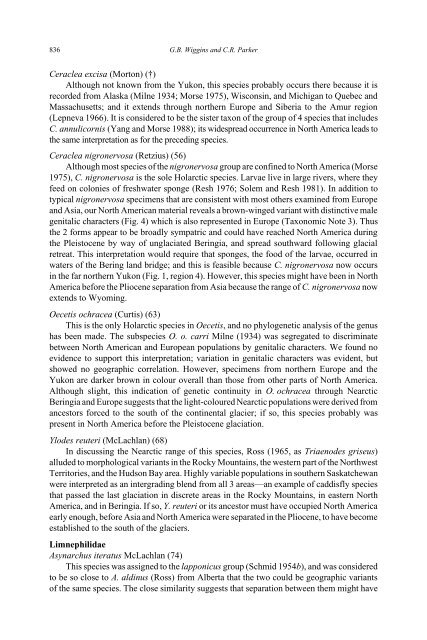Caddisflies of the Yukon - Department of Biological Sciences ...
Caddisflies of the Yukon - Department of Biological Sciences ...
Caddisflies of the Yukon - Department of Biological Sciences ...
Create successful ePaper yourself
Turn your PDF publications into a flip-book with our unique Google optimized e-Paper software.
836 G.B. Wiggins and C.R. Parker<br />
Ceraclea excisa (Morton) (†)<br />
Although not known from <strong>the</strong> <strong>Yukon</strong>, this species probably occurs <strong>the</strong>re because it is<br />
recorded from Alaska (Milne 1934; Morse 1975), Wisconsin, and Michigan to Quebec and<br />
Massachusetts; and it extends through nor<strong>the</strong>rn Europe and Siberia to <strong>the</strong> Amur region<br />
(Lepneva 1966). It is considered to be <strong>the</strong> sister taxon <strong>of</strong> <strong>the</strong> group <strong>of</strong> 4 species that includes<br />
C. annulicornis (Yang and Morse 1988); its widespread occurrence in North America leads to<br />
<strong>the</strong> same interpretation as for <strong>the</strong> preceding species.<br />
Ceraclea nigronervosa (Retzius) (56)<br />
Although most species <strong>of</strong> <strong>the</strong> nigronervosa group are confined to North America (Morse<br />
1975), C. nigronervosa is <strong>the</strong> sole Holarctic species. Larvae live in large rivers, where <strong>the</strong>y<br />
feed on colonies <strong>of</strong> freshwater sponge (Resh 1976; Solem and Resh 1981). In addition to<br />
typical nigronervosa specimens that are consistent with most o<strong>the</strong>rs examined from Europe<br />
and Asia, our North American material reveals a brown-winged variant with distinctive male<br />
genitalic characters (Fig. 4) which is also represented in Europe (Taxonomic Note 3). Thus<br />
<strong>the</strong> 2 forms appear to be broadly sympatric and could have reached North America during<br />
<strong>the</strong> Pleistocene by way <strong>of</strong> unglaciated Beringia, and spread southward following glacial<br />
retreat. This interpretation would require that sponges, <strong>the</strong> food <strong>of</strong> <strong>the</strong> larvae, occurred in<br />
waters <strong>of</strong> <strong>the</strong> Bering land bridge; and this is feasible because C. nigronervosa now occurs<br />
in <strong>the</strong> far nor<strong>the</strong>rn <strong>Yukon</strong> (Fig. 1, region 4). However, this species might have been in North<br />
America before <strong>the</strong> Pliocene separation from Asia because <strong>the</strong> range <strong>of</strong> C. nigronervosa now<br />
extends to Wyoming.<br />
Oecetis ochracea (Curtis) (63)<br />
This is <strong>the</strong> only Holarctic species in Oecetis, and no phylogenetic analysis <strong>of</strong> <strong>the</strong> genus<br />
has been made. The subspecies O. o. carri Milne (1934) was segregated to discriminate<br />
between North American and European populations by genitalic characters. We found no<br />
evidence to support this interpretation; variation in genitalic characters was evident, but<br />
showed no geographic correlation. However, specimens from nor<strong>the</strong>rn Europe and <strong>the</strong><br />
<strong>Yukon</strong> are darker brown in colour overall than those from o<strong>the</strong>r parts <strong>of</strong> North America.<br />
Although slight, this indication <strong>of</strong> genetic continuity in O. ochracea through Nearctic<br />
Beringia and Europe suggests that <strong>the</strong> light-coloured Nearctic populations were derived from<br />
ancestors forced to <strong>the</strong> south <strong>of</strong> <strong>the</strong> continental glacier; if so, this species probably was<br />
present in North America before <strong>the</strong> Pleistocene glaciation.<br />
Ylodes reuteri (McLachlan) (68)<br />
In discussing <strong>the</strong> Nearctic range <strong>of</strong> this species, Ross (1965, as Triaenodes griseus)<br />
alluded to morphological variants in <strong>the</strong> Rocky Mountains, <strong>the</strong> western part <strong>of</strong> <strong>the</strong> Northwest<br />
Territories, and <strong>the</strong> Hudson Bay area. Highly variable populations in sou<strong>the</strong>rn Saskatchewan<br />
were interpreted as an intergrading blend from all 3 areas—an example <strong>of</strong> caddisfly species<br />
that passed <strong>the</strong> last glaciation in discrete areas in <strong>the</strong> Rocky Mountains, in eastern North<br />
America, and in Beringia. If so, Y. reuteri or its ancestor must have occupied North America<br />
early enough, before Asia and North America were separated in <strong>the</strong> Pliocene, to have become<br />
established to <strong>the</strong> south <strong>of</strong> <strong>the</strong> glaciers.<br />
Limnephilidae<br />
Asynarchus iteratus McLachlan (74)<br />
This species was assigned to <strong>the</strong> lapponicus group (Schmid 1954b), and was considered<br />
to be so close to A. aldinus (Ross) from Alberta that <strong>the</strong> two could be geographic variants<br />
<strong>of</strong> <strong>the</strong> same species. The close similarity suggests that separation between <strong>the</strong>m might have
















